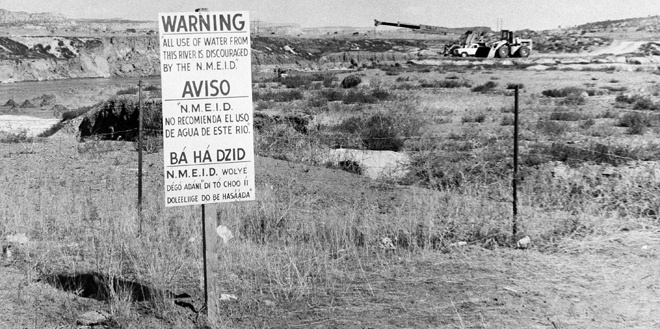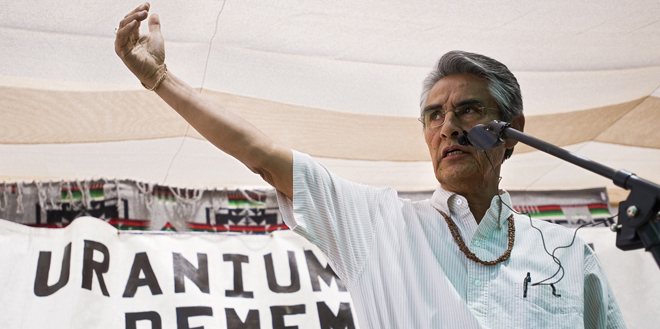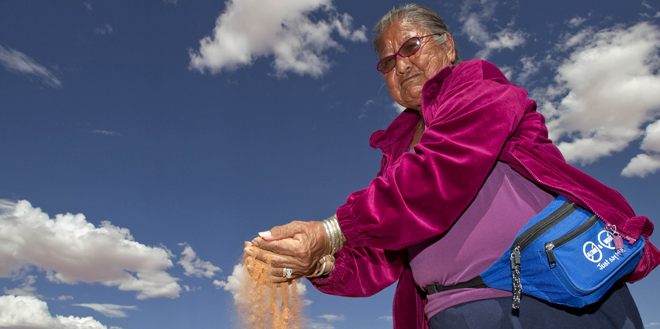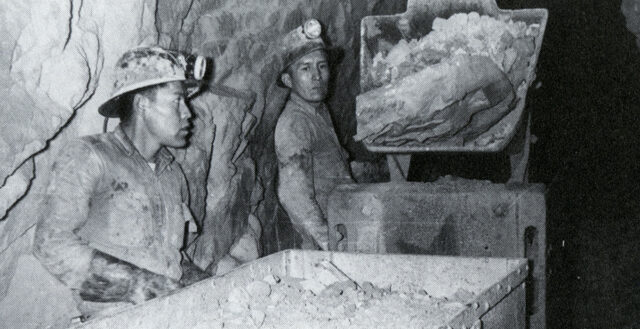Thirty-four years after the first atomic test in 1945—to the day and hour—a clap of sound like thunder echoed through the eastern part of the Navajo Nation, near Church Rock, New Mexico. On the morning of July 16, 1979, neighbors and mill workers woke to the collapse of the huge earthen dam at the United Nuclear Corporation Church Rock uranium mill. The accident released 1,000 tons of radioactive mill tailings—radium-laced sandy debris left over from the extraction and concentration of uranium—and 93 million gallons of acidic and radioactive wastewater into a deeply cut creek that flowed into the Rio Puerco. The waste flowed downstream at least 80 miles through the arid, rocky landscape past the homes of some 1,700 Navajo people.
That summer day in 1979 Native Americans awoke to the broader ecological impacts of uranium mining. Patches of radioactive hot spots were scraped only from the first five miles of the riverbed, and contamination problems remain to this day. The U.S. Geological Survey considers the Church Rock incident the largest accidental radioactive release in the United States. Earlier that year the nuclear accident at Three Mile Island power plant made national and international news; the Church Rock accident did not, even though it distributed more than three times (46 curies) the radiation levels of the Three Mile Island accident (13 curies). For Church Rock residents there was no state of emergency, no evacuation, and limited alternative water supplies.
The response to the Church Rock accident was not an anomaly. Native American miners—Navajo, Pueblo, and Hopi—had been working in underground uranium and vanadium mines since 1941 without the health precautions standard in other mines, such as pumping in fresh air for ventilation to dilute radon concentration. (Radon, a decay product of uranium, can cause lung cancer if inhaled.) Miners worked in dim underground mines using pneumatic drills that gouged holes in the rock for planting dynamite. After the explosion collapsed the ore vein, miners were often ordered back inside before the uranium and silica dust had a chance to settle. The dust swirled around them so thickly they could barely see to shovel the blasted ore into the carts. Trucks later took the raw ore to mills that used sulfuric acids and alkaline chemicals to leach out the uranium and concentrate it into yellowcake for use elsewhere. Left behind in ponds and unmarked piles was the radioactive debris. The nearby Nevada Test Site, a nuclear-weapons testing facility, produced its own hazards, which the prevailing winds then blew across the Navajo lands. The uranium mined from these lands fueled the nuclear reactors at Hanford Nuclear Reservation in Washington State, which made plutonium for nuclear weapons, and later fueled civilian nuclear-power plants.
The Navajo Nation was littered with abandoned, open, and radon-emitting former mine sites—at least 1,032 of them.
Nuclear-industry spokespersons, U.S. government agencies, and nuclear scientists often state that no one has ever been killed or harmed by the operations of a civilian nuclear-power plant in the United States. For example, the Department of Energy website and its brochures state that U.S. utilities have operated commercial nuclear-power plants since 1957 and “during this time, no one in the United States has died or been injured as a result of operations at a commercial nuclear power plant.” Yet by the time uranium mining finally petered out in the early 1980s, hundreds of Indian miners had died from lung diseases and cancers that physicians and secret U.S. Public Health studies linked to the miners’ uranium exposure. The Navajo Nation was littered with abandoned, open, and radon-emitting former mine sites—at least 1,032 of them. The United Nuclear Corporation mill and adjacent mine had become Superfund sites, and the cancer rate had doubled on Navajo lands. In addition, until 1980 untreated water was discharged from the mining and milling companies into the Rio Puerco at a rate of 2.8 billion gallons per year. Mine waste was dumped in piles where children played until the 1990s.
A multiagency remediation of the landscape begun in 2008 is now in its final year. To date the Environmental Protection Agency (EPA) and Navajo Nation EPA has removed 14 homes, 20 other structures, and 18 residential yards because of contamination. Also, 38 water wells, streams, and other water sources were found to exceed health limits for radionuclides. Written warnings in both Diné (Navajo) and English are posted on wells whose water is unsafe to drink.
Men at Work
Perry H. Charley is a man whose life has been irrevocably altered by and intertwined with uranium. Like many other Native Americans, Charley was sent to boarding school as part of the U.S. government and Bureau of Indian Affairs efforts to assimilate Indians. At Shiprock Boarding School his hair was cut off, and he was treated with insecticide against lice. “I was told to never speak my language again, but I sit here today as a fluent-speaking Navajo,” Charley says. “To repair as best I can what was lost, that has been my life’s work.” The boarding school trained him as an upholsterer, but the intelligent and resentful boy fought his way into architectural drafting. When at home on school breaks, he soaked up knowledge about his culture.

Charley grew up hearing traditional origin stories. He was taught that the birth of the tribe was preceded by the choice between two yellow powders. The powder of the corn pollen was chosen, and the Navajo were instructed to leave the mysterious yellow dirt alone. But in 1919 native reservation lands were opened to leasing by the Secretary of the Interior, and prospecting began despite the sovereignty rights guaranteed by the U.S.-Navajo Treaty of 1868. The Vanadium Corporation of America began secret uranium mining for the atomic-bomb project on Navajo lands in 1943. At the time neither the miners nor the tribal leadership were told what they were mining. The top-secret status of the atom-bomb project and later cold-war security fears created a lasting imprint on nuclear culture that led to the withholding of information. Health studies on the miners and even the locations of the mines were kept secret.
When the mining began, the Navajo, Hopi, and Pueblo men hired as miners spoke little to no English and worked in the unventilated mines without protective gear, sometimes without even gloves. Government documents show that at least some hazards were recognized at the time, including the dangers of poor ventilation and the toxicity of uranium. But during the war the military ignored health concerns in the rush to obtain uranium. After the war state regulators and the Bureau of Mines lacked the authority and the expertise to regulate radiation. The more powerful U.S. Atomic Energy Commission (AEC) along with the mining industry disputed the accumulating scientific evidence linking radon to cancer, until miner deaths, on the Indian reservations and beyond, reached into the hundreds and proved impossible to ignore. Only in 1969 did the federal government institute labor regulations to protect all uranium miners.
In the meantime instruments recorded high radon counts in the mines owing to the lack of ventilation, a lack noted on the occasional visits by state and federal health authorities. Indian miners in particular received no health warnings, drank water from cracks in mine walls, ate their lunch in the often just blasted mine, and returned home covered in a fine layer of yellow uranium dust. They sometimes used rocks and debris from the mining sites as building materials.
When Perry Charley was 14, his father, Harris Charley, moved out of the house to a brush arbor, a traditional temporary shelter built away from the home. In Navajo culture death contaminates the home; so when Charley returned from school and saw his father in the arbor, he immediately understood his father was dying. Harris struggled to explain his mysterious illness, which his son later discovered to be respiratory failure from fibrosis of the lung, a disease with which the Navajo had no experience. “My father was diagnosed with some disease, a lung problem, that was not explained and he could not understand,” says Charley. Like many of the ill miners, Harris was fired from the mine as soon as he became sick. During his father’s long illness, which ended with his death in 1986, Charley discovered the trajectory of his life. “I wanted to know why it happened and who was responsible for what my dad was subjected to. Those thoughts took me on a long, long course . . . that I continue to follow even to this day.”
‘My father was diagnosed with some disease, a lung problem, that was not explained and he could not understand.’
Charley, who prefers to describe himself as a simple sheepherder, earned a B.S. in environmental science in 1979 from the University of Arizona. He came to the attention of Stewart Udall, who had served as Secretary of the Interior from 1961 to 1969. Udall retained Charley as an investigator for his law firm, researching information about miners who were falling ill on the Navajo lands. The two found documents from a secret study initiated by the Indian Health Service and the Public Health Service. “We saw a list,” says Charley. “It is still so vivid in my mind, a list of thousands of names of miners who were studied, without their knowledge or consent. The first study began in 1949 to see what would happen to them in the uranium mines with high concentrations of radon.” Of the 3,415 names listed in the secret study of miners throughout the Southwest, 779 were Indian. “I started to see the names of people I knew, Begays, Benallys, and then . . . I saw my dad’s name.”
Even after the study confirmed the dangers and the links between uranium mining and cancer, the miners were never told. Charley says the documents showed the government had “decided to . . . not inform participants because it would have caused a mass exodus from the mines.” Instead, the study was used to establish allowable doses and regulatory health standards for future miners and nuclear workers. “The miners were sacrificed as guinea pigs,” says Charley.
Udall filed several lawsuits in 1979 on behalf of the widows of the miners and of miners sick and dying of cancer, including Harris, whose medical records showed a cumulative exposure of 1,192 working level months (WLMs). The WLM is a defined measurement of worker exposure to alpha radiation from the airborne decay of radium, which is found in uranium ores. As the radium decays, it produces dangerous radon gas that then itself decays, emitting radioactive ions that adhere easily to lung tissue. For comparison the United States no longer allows exposure of over four WLMs per year, and a respirator is required if a person is working in a mine for more than one WLM. Harris would have had to work for 298 years to remain within the safety standards for his cumulative exposure.
A combination of lawsuits, agitation by miners’ widows and local nonprofits, and sympathetic news reporters brought the history of uranium mining and its consequences to light. The government eventually held hearings to gather information. Harris traveled to Grants, New Mexico, in 1979 to testify at one of the first hearings on occupational health hazards. By 1982 he was too sick to testify, and his final testimony was read by his son. Harris eventually slipped into a coma, and the son was left to watch his father waste away. “In the end,” Charley says, “I could carry him and hold him in my arms, like a small child.”
The lawsuit filed by Udall ultimately failed two years after Harris’s death, in 1988, when the Supreme Court refused to hear the final appeal, allowing a lower court ruling to stand. This 1985 ruling, while admitting the case “cries out for redress,” held that the government was immune to blame, protected by the “discretionary function” that allows it to disregard health consequences in some circumstances. Government responsibility was undeniable, especially since a government agency, the AEC, had been the only purchaser of uranium during the era of unventilated mines and the miner’s health studies. Congress soon passed the Radiation Exposure Compensation Act (RECA), which was signed by President George H. W. Bush in 1990. Perry Charley remembers the day President Bush called him from Air Force One to inform him he was signing the bill. Poignantly, says Charley, Bush called as he flew over the Trinity site, where the first atomic-weapons test was carried out on July 16, 1945.
The U.S. Department of Justice, which had argued against the implementation of RECA, was now forced to administer it. The act eventually included mill workers, atomic soldiers, and downwinders, but many were denied compensation because of cultural ignorance and the limitations of the act itself. For example, even ceremonial use of tobacco for nonsmokers left them ineligible for compensation. To further complicate matters the government insisted on birth and marriage certificates, which in many cases did not exist.
Then there was the question of the abandoned mines, which became Charley’s responsibility. The location of these mines was often in doubt owing to poor record keeping and the sheer number of small mining claims. Along with the large corporations, such as Kerr McGee and Vanadium Corporation of America, there existed small, independent Native American–owned uranium mines. These shallow mines employed one to two miners and were encouraged by the Navajo Tribal Council and Small Business Administration programs as part of the AEC’s efforts to stockpile uranium. The Navajo Abandoned Mines Lands Reclamation Department began a detailed inventory in 1989. Contaminated mining debris, or overburden, the rocks and materials displaced by the removal of uranium, were backfilled into the mine shaft, after which the mine entrance was covered with uncontaminated dirt and replanted with vegetation. Sometimes mine entrances were capped with concrete. The department successfully reclaimed almost 90% of abandoned mine sites situated close to homes and communities. Yet these mines and the remaining 10% continue to be of concern; their radioactive and toxic dangers are still being assessed.
Charley kept Udall informed as the environmental contamination came to light on the Navajo lands. He dealt with both mines and uranium mills since the mills also affected nearby communities, the contamination of which led to the Uranium Mill Tailing Radiation Control Act of 1978. “I spent most of my life following the trail of these mill processing sites,” says Charley of the 27 sites in 10 states, all but three covered by the act. (Four of the country’s 22 severely contaminated mill-tailings sites lie in the Navajo Nation.) “Under the land there are millions of gallons of contaminated water.” In addition, the unregulated mining burden, often containing radioactive debris and rocks, was left in unmarked piles on the Navajo lands; as much as 85% of their original radioactivity remains. Today, the EPA has authority to protect the public and the environment from exposure to these wastes, which are now classified as technologically enhanced naturally occurring radioactive materials.
Speaking Out
In 1996 Charley cofounded the Uranium Education Program at Diné College, a traditional Native American college, where he teaches students and continues his research. The ongoing legal and legislative fight over justice for the uranium miners turned Charley into an environmental and health contamination expert. He integrates traditional practices with scientific methods, such as asking for blessings to help in remediation of contaminated areas or before collecting ants for the Navajo Ant Project, the first study of ant biodiversity on the Navajo Nation. (The study has found new species and is a collaboration between Diné College and Harvard University). In addition, Charley and his students conduct bio-uptake studies at the college orchard and with various experimental plantings to better understand interactions between the contaminated mill-tailing water and the environment.

Charley has often spoken with officials and the public about the radioactive contamination and frequently visits the Navajo chapter houses to speak with Navajo about the issues. He has found funding for health and environmental studies, such as one by the March of Dimes that discovered there was an elevated risk for birth defects near mining sites. He also involved community members in testing for contamination; they found dangerous amounts of radioactivity in Navajo homes from the mine debris used as building materials and mixed into concrete for flooring. Elsie Mae Begay’s family hogan (a traditional Navajo home) was sufficiently radioactive to be considered nuclear waste by the EPA and was dismantled and removed in 2001 by men in radiation suits. Begay had lost two sons to rare cancers.
For the Navajo the resulting ecological problems have become more complex as the radioactive and toxic mining and milling debris integrate into the biota. Water from wells and plants used in ceremonies and sweat lodges give additional exposure. Charley says that on the Navajo Nation the Diné believe they are protected within the boundaries of four sacred mountains that mark the edges of their traditional lands: “We coexist with nature out there. It is our Mother, and Sky is our Father, and we coexist. Everything has a place, a purpose, our brothers and sisters that are four legged, it is all in a world that is alive and thriving. So we had no concept that something that we coexisted with . . . would be so damaging to our entire society.” There are no Diné words for radon progenies and radioactivity, or for alpha and beta particles, or gamma radiation. But Charley is changing that with his glossaries, constructing Navajo words for radiation-related terms.
There are no Diné words for radon progenies and radioactivity, or for alpha and beta particles, or gamma radiation.
From 2002 to 2006 Charley served on the National Academy of Sciences Committee on Improving Practices for Regulating and Managing Low-Activity Radioactive Wastes. The committee’s final report achieved little, but Charley’s work joined a cacophony of efforts at the grassroots level, which included decades of work by many small, community-advocacy organizations. Filmmaker Jeff Spitz made a documentary, The Return of Navajo Boy, chronicling the lives of Elsie Mae Begay and her family. In 2006 journalist Judy Pasternak published an in-depth, two-part report in the Los Angeles Times called “Blighted Homeland: A Peril That Dwelt among the Navajos.” Congressional hearings followed in 2007 and led to the five-year, multiagency cleanup plan, which began in 2008 but failed to meet the primary requests of the Navajo: removing all remaining contaminants off the Navajo lands along with a comprehensive health study.
While removing all contamination from thousands of square miles may well be financially and logistically unfeasible, a new health study has just begun. The Navajo Birth Cohort Study, led by the Centers for Disease Control and Prevention, will look at the public-health impacts of mining and milling from before birth into childhood.
Uncertain Future
Uranium mining may soon return to Navajo lands despite the 2005 banning of mining by the Navajo Nation. The Nuclear Regulatory Commission (NRC) has awarded four in situ uranium mining licenses to mine on Navajo lands and immediately adjacent to the Navajo Nation. All legal avenues to stop the threatened mining, which uses water to leach out uranium, have been exhausted. A local group, with the help of the New Mexico Environmental Law Center, submitted a petition to the Inter-American Commission on Human Rights in 2011, arguing that the NRC’s decision to grant Hydro Resources, Inc., a license to mine uranium ore is a violation of national and international laws, including the 2007 United Nations Declaration on the Rights of Indigenous Peoples, a document supported as U.S. policy since 2010.

Opponents fear the mines might contaminate drinking water for 15,000 Navajo residents in and around the two communities of Church Rock and Crownpoint, New Mexico, just outside the boundaries of the Navajo Nation. Uranium is not the only current environmental-health threat: five coal-fired plants surround the Navajo Nation. “We also have a rich reserve of coal,” says Charley, “and two of the most polluting power plants in America. . . . The air in the four corners area is yellow, and that is what we are breathing.” Despite the pollution, tribal administrators approved the building of another coal-fired plant. “Some of the very same public health impacts that I see in the coal industry I have seen and I have documented . . . on the uranium sites. They may have different names but the same respiratory disease, the same cancer, the same birth defects, the same environmental impacts in both of these industries. Put a ban on one and advocate the other.” Charley adds, “If this same contamination were in New York, it would be a Superfund site. But we do not have the population numbers to fulfill the criteria to qualify for Superfund cleanup. There are too few of us.”
For the Navajo the resulting ecological problems have become more complex as the radioactive and toxic mining and milling debris integrate into the biota.
Charley is being treated for a cancer in his throat, which doctors attribute to his years of living on the Navajo Nation and to his work on the abandoned mines. “In all my years, I never thought it would happen to me and I would be another victim,” says Charley. Despite his illness Charley continues to research, work, and teach at Diné College; to direct outreach for the Diné College Environmental Institute; and to speak to the public and to officials. He continues to build his glossary.
In 2011 Charley attended the annual meeting of the American Society for Environmental History. The Return of Navajo Boy was shown and followed by a discussion with panelists, including Charley; the filmmaker, Jeff Spitz; and the elder followed in the film, Elsie Mae Begay. Charley then produced a scintillation counter for measuring radiation and placed it next to a hand-sized piece of uranium rock sealed within several plastic bags. He asked the audience to imagine living their whole lives surrounded by rocks and debris from uranium mining sites. When he flipped the switch, the clicks began, coming louder and faster, the noise consuming the room. “Imagine living where this [rock] is thousands of times more prevalent, all around you, as in some areas of the Navajo Reservation, for almost three generations.” The audience listened, silent, except for the audible gasps.




